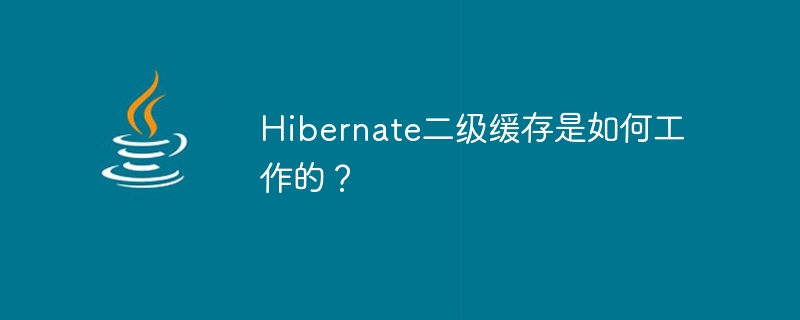Hibernate二级缓存是如何工作的?

缓存有助于减少执行查询时的数据库网络调用。
一级缓存与会话链接。它是隐式实现的。一级缓存存在 直到会话对象存在为止。一旦会话对象终止/关闭,将会有 没有缓存对象。二级缓存适用于多个会话对象。它是链接的 与会话工厂。二级缓存对象可供所有会话使用 单会话工厂。当特定会话发生时,这些缓存对象将被终止 工厂已关闭。
实现二级缓存
我们需要添加以下依赖项才能使用二级缓存。
<!-- https://mvnrepository.com/artifact/net.sf.ehcache/ehcache --> <dependency> <groupId>net.sf.ehcache</groupId> <artifactId>ehcache</artifactId> <version>2.10.9.2</version> </dependency> <!-- https://mvnrepository.com/artifact/org.hibernate/hibernate-ehcache --> <dependency> <groupId>org.hibernate</groupId> <artifactId>hibernate-ehcache</artifactId> <version>5.4.32.Final</version> </dependency>
注意- hibernate ehcache 版本号必须与 hibernate 版本号相同。
现在,我们需要添加 hibernate 配置文件,这将使 hibernate 能够连接到 提供的数据库并使用二级缓存。
<!DOCTYPE hibernate-configuration PUBLIC
"-//Hibernate/Hibernate Configuration DTD 3.0//EN"
"http://www.hibernate.org/dtd/hibernate-configuration-3.0.dtd">
<hibernate-configuration>
<session-factory>
<!-- JDBC Database connection settings -->
<property name="connection.driver_class">com.mysql.cj.jdbc.Driver</property>
<property name="connection.url">jdbc:mysql://localhost:3306/demo?useSSL=false</property>
<property name="connection.username">root</property>
<property name="connection.password">root</property>
<!-- JDBC connection pool settings ... using built-in test pool -->
<property name="connection.pool_size">4</property>
<!-- Echo the SQL to stdout -->
<property name="show_sql">true</property>
//caching properties
<property name="cache.use_second_level_cache">true</property>
<property name="cache.region.factory_class">org.hibernate.cache.ehcache.EhCacheRegionFactory</property>
<!-- Select our SQL dialect -->
<property name="dialect">org.hibernate.dialect.MySQL5Dialect</property>
<!-- Drop and re-create the database schema on startup -->
<property name="hbm2ddl.auto">create-drop</property>
<!-- name of annotated entity class -->
<mapping class="academy.company.Parent"/>
</session-factory>
</hibernate-configuration>
示例
默认情况下,java 中的所有实体都是不缓存的。因此,为了启用实体的缓存,我们在实体类 Parent 中使用 @Cacheable 和 @Cache 注释 -
import org.hibernate.annotations.CacheConcurrencyStrategy;
import javax.persistence.*;
@Entity
@Table( name = " Employee")
@Cacheable
@org.hibernate.annotations.Cache(usage = CacheConcurrencyStrategy.READ_ONLY)
public class Parent {
@Id
@GeneratedValue(strategy = GenerationType.AUTO)
Long id;
@Column(name = "first_name")
String firstName;
@Column(name = "last_name")
String lastName;
}
Now, let’s check whether second level cache works:
import org.hibernate.Session;
import org.hibernate.SessionFactory;
import org.hibernate.cfg.Configuration;
public class Main {
public static void main(String[] args) {
SessionFactory sessionFactory = new Configuration()
.configure("academy/company/hibernate.cfg.xml")
.buildSessionFactory();
Session session1 = sessionFactory.openSession();
Parent parent1 = session1.get(Parent.class, 4);
System.out.println(parent1.id + " " + parent1.firstName + " " + parent1.lastName);
session1.close();
Session session2 = sessionFactory.openSession();
Parent parent2 = session2.get(Parent.class, 4);
System.out.println(parent2.id + " " + parent2.firstName + " " + parent2.lastName);
session2.close();
}
}
输出
Hibernate: select parent0.id as id1, parent0.first_name as first_name1, parent0.last_name as last_name1 from Parent parent0 where parent0.id=? 1 Subash Chopra 1 Subash Chopra
从控制台我们可以清楚地看到hibernate在session1期间只执行了一次查询。现在,当 session2 访问相同的查询时,它不会对数据库进行网络调用来执行它。相反,由于我们使用二级缓存,它将从 session1 获取缓存对象。
以上是Hibernate二级缓存是如何工作的?的详细内容。更多信息请关注PHP中文网其他相关文章!

热AI工具

Undresser.AI Undress
人工智能驱动的应用程序,用于创建逼真的裸体照片

AI Clothes Remover
用于从照片中去除衣服的在线人工智能工具。

Undress AI Tool
免费脱衣服图片

Clothoff.io
AI脱衣机

AI Hentai Generator
免费生成ai无尽的。

热门文章

热工具

记事本++7.3.1
好用且免费的代码编辑器

SublimeText3汉化版
中文版,非常好用

禅工作室 13.0.1
功能强大的PHP集成开发环境

Dreamweaver CS6
视觉化网页开发工具

SublimeText3 Mac版
神级代码编辑软件(SublimeText3)

热门话题
 mybatis的一级缓存和二级缓存是什么
Jan 15, 2024 pm 01:44 PM
mybatis的一级缓存和二级缓存是什么
Jan 15, 2024 pm 01:44 PM
mybatis的一级缓存是默认开启的,并且是SqlSession级别的。这意味着同一SqlSession中的多次查询会利用到该级别的缓存。一级缓存主要存储的是查询结果。当执行查询操作时,MyBatis会将映射语句和查询结果的映射关系以及查询结果数据存储在缓存中。mybatis的二级缓存与一级缓存不同,二级缓存在整个应用程序中是共享的,不像一级缓存在每个SqlSession等等。
 解析MyBatis的缓存机制:比较一级缓存和二级缓存的特点和用法
Feb 25, 2024 pm 12:30 PM
解析MyBatis的缓存机制:比较一级缓存和二级缓存的特点和用法
Feb 25, 2024 pm 12:30 PM
MyBatis的缓存机制解析:一级缓存与二级缓存的区别与应用在MyBatis框架中,缓存是一个非常重要的特性,可以有效提升数据库操作的性能。其中,一级缓存和二级缓存是MyBatis中常用的两种缓存机制。本文将详细解析一级缓存与二级缓存的区别与应用,并提供具体的代码示例进行说明。一、一级缓存一级缓存也被称为本地缓存,它默认开启且不可关闭。一级缓存是SqlSes
 SpringBoot项目里怎么集成Hibernate
May 18, 2023 am 09:49 AM
SpringBoot项目里怎么集成Hibernate
May 18, 2023 am 09:49 AM
在SpringBoot项目中集成Hibernate前言Hibernate是一个流行的ORM(对象关系映射)框架,它可以将Java对象映射到数据库表,从而方便地进行持久化操作。在SpringBoot项目中,集成Hibernate可以帮助我们更轻松地进行数据库操作,本文将介绍如何在SpringBoot项目中集成Hibernate,并提供相应的示例。1.引入依赖在pom.xml文件中引入以下依赖:org.springframework.bootspring-boot-starter-data-jpam
 Java错误:Hibernate错误,如何处理和避免
Jun 25, 2023 am 09:09 AM
Java错误:Hibernate错误,如何处理和避免
Jun 25, 2023 am 09:09 AM
Java是一种面向对象编程语言,它被广泛地应用于软件开发领域。Hibernate是一种流行的Java持久化框架,它提供了一种简单且高效的方式来管理Java对象的持久化。然而,开发过程中经常会遇到Hibernate错误,这些错误可能会导致程序的异常终止或者不稳定。如何处理和避免Hibernate错误成为了Java开发者必须掌握的能力。本文将介绍一些常见的Hib
 2023年我可以用Java技能申请哪些工作?
Sep 21, 2023 am 11:41 AM
2023年我可以用Java技能申请哪些工作?
Sep 21, 2023 am 11:41 AM
当我们谈论编程语言和工作时,我们想到的一种编程语言是Java。全世界大多数公司都使用Java。它很受欢迎,而且有很多工作机会。如果您想在2023年借助Java技能找到工作,那么这对您有好处,因为Java技能可以让您快速找到工作。此外,它还能快速提升你的职业生涯。没有什么魔法能让你快速找到工作。但你的技能对你来说就像魔法一样。选择一份让你满意的工作和一个能够极大提升你职业生涯的良好环境。如果你是一个刚入行且有经验的人,Java也给你提供了一份不错的工作。许多公司使用Java作为其开发的主要程序。它
 hibernate和mybatis有哪些区别
Jan 03, 2024 pm 03:35 PM
hibernate和mybatis有哪些区别
Jan 03, 2024 pm 03:35 PM
hibernate和mybatis的区别:1、实现方式;2、性能;3、对象管理的对比;4、缓存机制。详细介绍:1、实现方式,Hibernate是一个完整的对象/关系映射解决方案,将对象与数据库表进行映射,MyBatis则需要开发者手动编写SQL语句以及ResultMap;2、性能,Hibernate在开发速度上可能比MyBatis快,因为Hibernate简化了DAO层等等。
 Java Hibernate中一对多和多对多关系的映射方式是什么
May 27, 2023 pm 05:06 PM
Java Hibernate中一对多和多对多关系的映射方式是什么
May 27, 2023 pm 05:06 PM
Hibernate的一对多和多对多Hibernate是一个优秀的ORM框架,它简化了Java应用程序与关系型数据库之间的数据访问。在Hibernate中,我们可以使用一对多和多对多的关系来处理复杂的数据模型。Hibernate的一对多在Hibernate中,一对多关系是指一个实体类对应多个另一个实体类。比如,一个订单(Order)可以对应多个订单项(OrderItem),一个用户(User)可以对应多个订单(Order)。要在Hibernate中实现一对多关系,需要在实体类中定义一个集合属性来存
 前端工程师职责解析:主要做什么工作?
Mar 25, 2024 pm 05:09 PM
前端工程师职责解析:主要做什么工作?
Mar 25, 2024 pm 05:09 PM
前端工程师职责解析:主要做什么工作?随着互联网的快速发展,前端工程师作为一个非常重要的职业角色,扮演着连接用户与网站应用程序的桥梁,起着至关重要的作用。那么,前端工程师主要做些什么工作呢?本文将对前端工程师的职责进行解析,让我们来一探究竟。一、前端工程师的基本职责网站开发与维护:前端工程师负责网站的前端开发工作,包括编写网站的HTML、CSS和JavaScr






